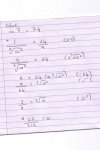You are using an out of date browser. It may not display this or other websites correctly.
You should upgrade or use an alternative browser.
You should upgrade or use an alternative browser.
index law quesrtion
- Thread starter neelam
- Start date
D
Deleted member 4993
Guest
hi, I have answered a question but there is no mark scheme, so could somebody please check it and tell me if I've done it right or wrong. The question and my working are on the attachment.
Your answer is correct - however lines 3 and 4 are not necessary.
HallsofIvy
Elite Member
- Joined
- Jan 27, 2012
- Messages
- 7,763
I think Subhotosh Khan means that you can go directly from \(\displaystyle \frac{1}{\sqrt[3]{x^2}}= \frac{64}{9}\) to \(\displaystyle \sqrt[3]{x^2}= \frac{9}{64}\) by inverting both sides: if \(\displaystyle \frac{a}{b}= \frac{c}{d}\) then \(\displaystyle \frac{b}{a}= \frac{d}{c}\).
D
Deleted member 4993
Guest
I would do it following way
\(\displaystyle \displaystyle x^{-\frac{2}{3}} \ = \ 7\frac{1}{9}\)
\(\displaystyle \displaystyle x^{-\frac{2}{3}} \ = \ \frac{64}{9}\)
\(\displaystyle \displaystyle x^{\frac{2}{3}} \ = \ \left (\frac{3}{8}\right )^2\)
\(\displaystyle \displaystyle \left [ x^{\frac{2}{3}}\right ]^{\frac{3}{2}} \ = \ \left [\left (\frac{3}{8}\right )^2 \right ]^{\frac{3}{2}}\)
\(\displaystyle \displaystyle x \ = \ \left (\frac{3}{8}\right )^3 \)
\(\displaystyle \displaystyle x^{-\frac{2}{3}} \ = \ 7\frac{1}{9}\)
\(\displaystyle \displaystyle x^{-\frac{2}{3}} \ = \ \frac{64}{9}\)
\(\displaystyle \displaystyle x^{\frac{2}{3}} \ = \ \left (\frac{3}{8}\right )^2\)
\(\displaystyle \displaystyle \left [ x^{\frac{2}{3}}\right ]^{\frac{3}{2}} \ = \ \left [\left (\frac{3}{8}\right )^2 \right ]^{\frac{3}{2}}\)
\(\displaystyle \displaystyle x \ = \ \left (\frac{3}{8}\right )^3 \)
What about the following?
\(\displaystyle x^{2/3} \ = \ \bigg(\dfrac{3}{8}\bigg)^2\)
\(\displaystyle (x^{2/3})^3 \ = \ \bigg[\bigg(\dfrac{3}{8}\bigg)^2\bigg]^3\)
\(\displaystyle x^2 \ = \ \bigg(\dfrac{3}{8}\bigg)^6\)
\(\displaystyle x \ = \ \pm\sqrt{\bigg(\dfrac{3}{8}\bigg)^6 \ }\)
\(\displaystyle x \ = \ \pm\bigg(\dfrac{3}{8}\bigg)^3 \)
\(\displaystyle x \ = \ \pm \dfrac{27}{512}\)
Cube root discussed in Wikipedia:
http://en.wikipedia.org/wiki/Cube_root
Formal definition
"The cube roots of a number x are the numbers y which satisfy the equation"

"If x and y are real, then there is a unique solution and so the cube root of a real number is sometimes defined by this equation.
If this definition is used, the cube root of a negative number is a negative number."
\(\displaystyle x^{2/3} \ = \ \bigg(\dfrac{3}{8}\bigg)^2\)
\(\displaystyle (x^{2/3})^3 \ = \ \bigg[\bigg(\dfrac{3}{8}\bigg)^2\bigg]^3\)
\(\displaystyle x^2 \ = \ \bigg(\dfrac{3}{8}\bigg)^6\)
\(\displaystyle x \ = \ \pm\sqrt{\bigg(\dfrac{3}{8}\bigg)^6 \ }\)
\(\displaystyle x \ = \ \pm\bigg(\dfrac{3}{8}\bigg)^3 \)
\(\displaystyle x \ = \ \pm \dfrac{27}{512}\)
Cube root discussed in Wikipedia:
http://en.wikipedia.org/wiki/Cube_root
Formal definition
"The cube roots of a number x are the numbers y which satisfy the equation"

"If x and y are real, then there is a unique solution and so the cube root of a real number is sometimes defined by this equation.
If this definition is used, the cube root of a negative number is a negative number."
Last edited:
\(\displaystyle \dfrac{1}{\sqrt[3]{x^2} \ } \ = \ \dfrac{64}{9} \ \ \ \ \ \ \ \ \ \ \ \ \)If this equation to the left is seen as an equivalent to the original equation, then it must be accepted that \(\displaystyle x \ = \ -\bigg(\dfrac{3}{8}\bigg)^3 \ \) is also a solution, as it checks in this equation.

